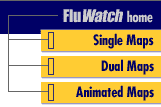Common menu bar links
E-mail this page
Fluwatch
Most regions in Canada reporting no influenza activity; sporadic influenza A laboratory detections still reported
During weeks 27 and 28, overall influenza activity in Canada remained low with the majority of the influenza surveillance regions reporting no activity (see map). The number of regions reporting sporadic influenza activity decreased from 11 regions in week 27 to 8 regions in week 28. The percentage of specimens that tested positive for influenza declined to 0.4% (6/1,528) for Canada as a whole over the two-week period (see table). To date this season, 58% of influenza detections in Canada were for influenza A viruses and 42% were for influenza B viruses. Note that parainfluenza virus detections remain elevated (~ 9%). This week, the ILI consultation rate increased to 21 ILI consultations per 1,000 patient visits (see ILI graph), which is above the expected range for this week, and the sentinel response rate was 33%. Fluctuations in ILI consultation rates are expected during periods of low influenza activity and low sentinel participation. No new outbreaks have been reported since week 22.
Antigenic Characterization & Antiviral Resistance:
No new antigenic characterizations or antiviral resistance results were reported by the National Microbiology Laboratory (NML) in weeks 27 and 28. Please see pie chart below or refer to the previous report for further information: http://www.phac-aspc.gc.ca/fluwatch/07-08/w23-24_08/index-eng.php.
Influenza-associated Paediatric Hospitalizations:
In weeks 27 & 28, there were no new laboratory-confirmed influenza-associated paediatric hospitalizations reported through the Immunization Monitoring Program Active (IMPACT) network; however a few cases were retrospectively reported from previous weeks. Of the 492 hospitalizations reported so far this season, 63% (310/492) have been due to influenza A. The proportion of cases to date by age group are as follows: 21% were 0-5 month olds; 26% were 6-23 month olds; 23% were 2-4 year-olds; 20% were 5-9 year-olds; and 10% were 10-16 year-olds. Since the start of the season, 3 influenza-associated pediatric deaths have been reported to PHAC, all due to influenza B infection.
International:
WHO: During weeks 26–27, the level of overall influenza activity in the world increased. In the southern hemisphere, considerable increase of influenza activity and increased detections of influenza viruses were observed. Influenza B and A(H3N2) circulated. Countries in the northern hemisphere reported sporadic or no activity.
EISS: In week 27, influenza virus detections were sporadic in Europe. Of the countries that reported an assessment of the geographical spread of influenza activity in week 27, none of them reported influenza activity.
Australia: Inter-seasonal levels of laboratory confirmed influenza notifications in 2008 in Australia have been higher in most states than in the previous five years and are possibly due to increased awareness and testing following the higher than normal season in 2007. Influenza A detections predominated (58%).
Human Avian Influenza: No new cases of human H5N1 avian influenza infection have been reported by the WHO since 19 June 2008.
Total number of influenza tests performed and number of positive tests by province/territory of testing laboratory, Canada, 2007-2008
| Province
of reporting laboratories |
Report Period: June 29, 2008 to July 12, 2008 |
Season to Date: August 26, 2007 to July 12, 2008 |
||||||
| Total
# Influenza Tests |
# of Positive Tests | Total
# Influenza Tests |
# of Positive Tests | |||||
| Influenza A | Influenza B | Total | Influenza A | Influenza B | Total | |||
| NL | 15 | 0 | 0 | 0 | 1537 | 85 | 133 | 218 |
| PE | 3 | 0 | 0 | 0 | 176 | 3 | 26 | 29 |
| NS | 25 | 0 | 0 | 0 | 1137 | 123 | 104 | 227 |
| NB | 20 | 0 | 0 | 0 | 1602 | 108 | 193 | 301 |
| QC | 315 | 1 | 0 | 1 | 32085 | 2238 | 1151 | 3389 |
| ON | 491 | 5 | 0 | 5 | 37740 | 2502 | 1811 | 4313 |
| MB | 52 | 0 | 0 | 0 | 2517 | 82 | 46 | 128 |
| SK | 99 | 0 | 0 | 0 | 6657 | 366 | 311 | 677 |
| AB | 484 | 0 | 0 | 0 | 33506 | 953 | 945 | 1898 |
| BC | 24 | 0 | 0 | 0 | 3774 | 589 | 477 | 1066 |
| Canada | 1528 | 6 | 0 | 6 | 120731 | 7049 | 5197 | 12246 |
Specimens from NT, YT, and NU are sent to reference laboratories in other provinces.
Note: Cumulative data includes updates to previous weeks; due to reporting delays, the sum of weekly report totals do not add up to cumulative totals.
Abbreviations: Newfoundland/Labrador (NL), Prince Edward Island (PE), New Brunswick (NB), Nova Scotia (NS), Quebec (QC), Ontario (ON), Manitoba (MB), Saskatchewan (SK), Alberta (AB), British Columbia (BC), Yukon (YT), Northwest Territories (NT), Nunavut (NU)
Respiratory virus laboratory detections in Canada, by geographic
regions, are available weekly on the following website:
<http://www.phac-aspc.gc.ca/bid-bmi/dsd-dsm/rvdi-divr/index-eng.php>
Number of influenza surveillance regions† reporting widespread or localized influenza activity, Canada, by report week, 2007-2008 (N=54)
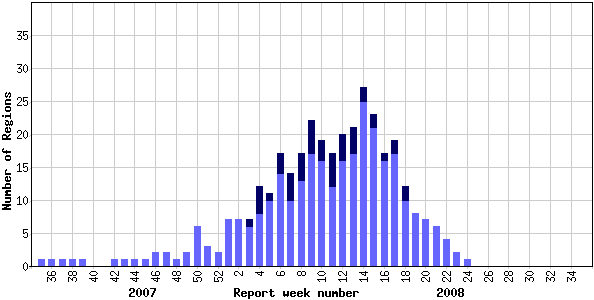
![]()
† sub-regions within the province or territory as defined by the provincial/territorial epidemiologist. Graph may change as late returns come in.
Influenza
Activity Level by Provincial and Territorial |
||||||||||||
|
||||||||||||
Note: Influenza activity levels, as represented on this map, are assigned and reported by Provincial and Territorial Ministries of Health, based on laboratory confirmations, sentinel ILI rates (see graphs and tables) and outbreaks. Please refer to detailed definitions. For areas where no data is reported, late reports from these provinces and territories will appear on the FluWatch website. Select single maps by report week to get this updated information.
<http://dsol-smed.phac-aspc.gc.ca/dsol-smed/fluwatch/fluwatch.phtml?lang=e>
Click on the map to view provinces/territories and maps for other weeks.
Influenza tests reported and percentage of tests positive, Canada, by report week, 2007-2008
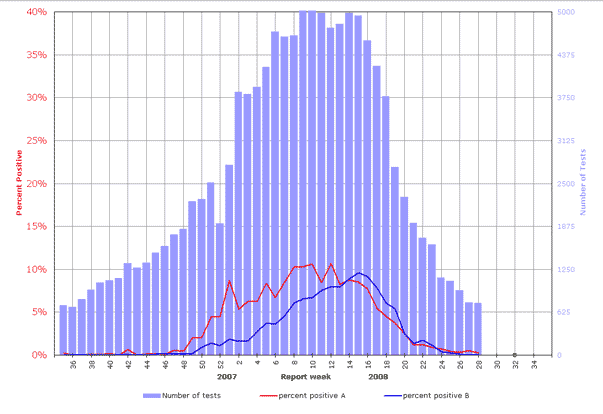
Percent positive influenza tests, compared to other respiratory viruses, Canada, by reporting week, 2007-2008
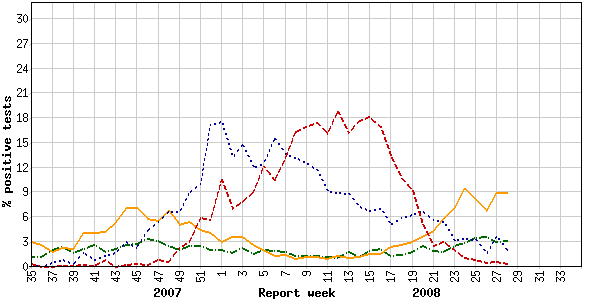
![]()
Influenza strain characterization, Canada, cumulative, 2007-2008 influenza season by the Respiratory Viruses Section at the National Microbiology Laboratory
[N=1,334]
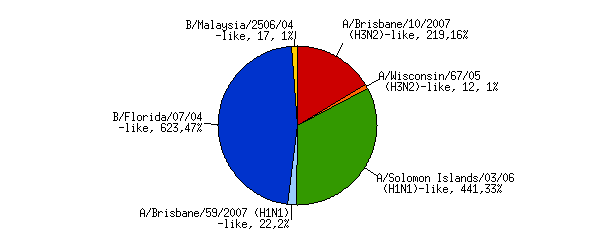
{Strain characterization, number identified, per cent of total number}
NACI recommends that the trivalent vaccine for the 2007-2008 season in Canada contain A/Solomon Islands/3/2006 (H1N1)-like virus; an A/Wisconsin/67/2005 (H3N2)-like virus; and a B/Malaysia/2506/2004-like virus.
Influenza-like illness (ILI) consultation rates, Canada, by report week, 2007-2008 compared to 1996/97 through to 2006/07 seasons

![]()
Note: No data available for mean rate in previous years for weeks 19 to 39 (1996-1997 through 2002-2003 seasons).
Number of New Outbreaks in Long Term Care Facilities, Canada, by Report Week, 2007-2008
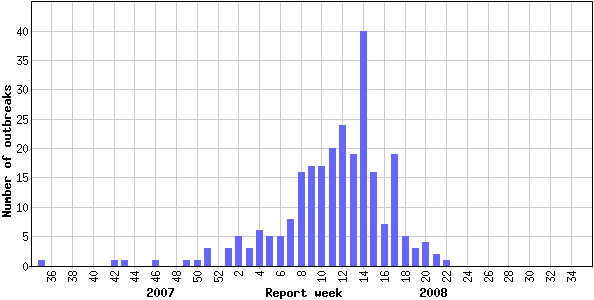
![]()
Please note that the above graphs may change as late returns come in.


